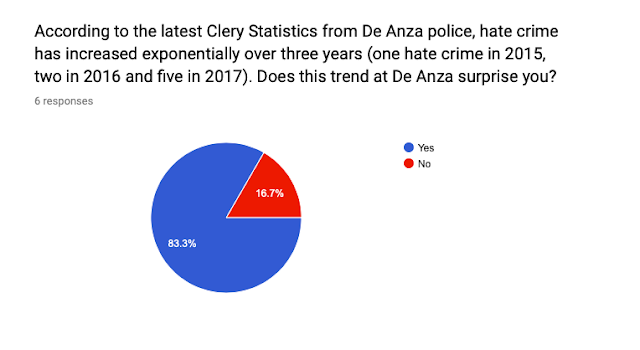Hate crime becoming more common at De Anza and nationally
While living in La Jolla, California, an Asian-American future De Anza College student experienced hate speech first hand when a stranger yelled from across a street, “Go back to your own country!”
Katie Trieu, 23, pharmaceutical chemistry major, said that her shock kept her from realizing how racist the comment was until after she had walked away.
Trieu is one of several De Anza students who said they realize hate is a growing problem in the United States, but were surprised that hate crime is growing at De Anza according to the De Anza College Police Department.
As shown in the 2018 Foothill-De Anza Clery Statistics Report, only one hate crime at De Anza was reported in 2015, while two were in 2016 and five were in 2017.
As shown in the 2018 Foothill-De Anza Clery Statistics Report, only one hate crime at De Anza was reported in 2015, while two were in 2016 and five were in 2017.
Trieu said she was surprised to learn about De Anza’s growing hate crime statistics because she believes the campus is diverse and generally accepting.
“I have not seen anybody be rude to somebody else just because of their race,” Trieu said. “But I think maybe I am just not looking out for that kind of stuff.”
Henry Lao, 23, computer science major, said he was also surprised by these statistics. “This area is very diverse.”
Lao said this trend is probably related to President Trump’s rhetoric on immigration.
Briana Cavaness, 35, psychology major, said she was not surprised by De Anza’s growing hate crime, although she said she had not seen any examples on campus. She said that “discord between political parties and hate speech from political parties” on a national scale influenced De Anza.
According to a 2018 FBI report, hate crimes rose 17 percent nationally in 2017 and 59.6 percent of victims were targeted because of their race.
Li Tran, 18, graphic design major, said she has observed a lot of hate crime through news coverage and not in person. She said she was specifically surprised by the amount of racially charged hate crimes and she thought racism would decrease because “people are more open-minded now.”
Cavaness said that modern racism in the U.S. is not surprising, and that media contributes to racism. She said news broadcasts use mugshots for African-American suspects while for white suspects, “They will use a good portrait of them.”
Vox reported in 2015 that the news websites thegazette.com and KCRG.com ran stories about two groups of men arrested for burglary during the same week, and that the sites used wrestling team pictures of the white men while the black men were displayed with mugshots.
Trieu said the easiest solution for her is to ignore hateful people, “just in case it does lead to something more violent or more aggressive.”
Muhammad Ali, 18, business administration major, said that ignoring hate speech is the best way to respond. “It is just words, right?” he said. “At the end of the day.”
Additional responses from a sample of six De Anza College students:
Click here to participate in a similar survey.
Additional responses from a sample of six De Anza College students:
Click here to participate in a similar survey.








Comments
Post a Comment